The Texas State Seal
Office of the Secretary of State
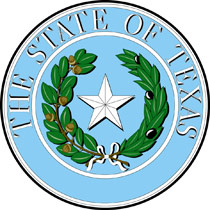
There shall be a Seal of the State which shall be kept by the secretary of state, and used by him officially under the direction of the governor. The Seal of the State shall be a star of five points, encircled by olive and live oak branches, and the words, "The State of Texas."
— Texas Constitution, article IV, section 19.
Text:
Charles A. Spain, Jr., chair, Texas State Seal Advisory Committee,based on research from Spain, Jr., Charles A. "The Flags and Seals of Texas."
South Texas Law Review (Houston), 33 (February 1992): 215-59.
Design:
Donna D. Darling, cochair, Texas State Seal Advisory Committee;layout by Juan Vega and Michael G. McCathern;
art by Juan Vega and Douglas Young.
Credits:
Photograph of Peter Krag painting of 1839 national flag and seal courtesyof the Archives Division-Texas State Library.
Photograph of Henry W. Schlattner painting of Texas State Seal courtesy
of the Texas Memorial Museum, accession number 1746.
Photograph of 1961 reverse of the state seal courtesy of
the State Preservation Board.
Information for "What is a Seal?" taken from
Patterson, Richard S., and Richardson Dougall.
The Eagle and the Shield: A History of the Great Seal of the United States.
Publication & Distribution:
Office of the Secretary of State
Statutory Documents Division
Post Office Box 13550
Austin, Texas 78711-3550
Copies of this publication have been distributed in compliance with the
State Depository Law and are available for public use through the
Texas State Publications Depository Program at the Texas State Library
and other state depository libraries.
The text of this pamphlet is not copyrighted and may be reproduced. The Office of the Secretary of State would appreciate credit for the material used and a copy of the reprint.
First Printing-October 1993
The Office of the Secretary of State does not discriminate on the basis of race, color, national origin, sex, religion, age or disability in employment or the provision of services.
The Texas State Seal
Office of the Secretary of State
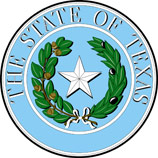
Foreword
In days when communications were transcribed by hand and tediously undertaken, seals served to authenticate official government documents. In this day of computers and instant communications, seals still serve the same purpose.
Since revolutionary times, Texas has chosen the Lone Star as its symbol. Despite the fact that Texans were at war with the federal government sitting in Mexico City, the Texas Provisional Government took the time to adopt an emblem of "a single star of five points, either of gold or silver" as the "peculiar emblem" of the Republic on March 12, 1836, only ten days after declaring independence! Nine months later this "peculiar emblem" provided the bases for the first Texas seal, which in two years would finally take on the form that we recognize today. This simple and graceful design now appears on official documents, identifies state aircraft, and adorns both the original and new portions of our capitol building.
It came to former Secretary of State John Hannah, Jr.'s attention in 1991 that although the secretary of state is the official keeper of the state seal, there was no uniform representation of what this seal actually looked like. He therefore appointed a committee that after much research agreed upon a uniform design for the state seal, state arms, and reverse of the state seal. The designs which were adopted appear in this pamphlet.
The Committee hopes that you find this exploration of a small part of Texas history as interesting as we did.
The State Seal Advisory Committee
Austin, Texas, April 1994.
What is a Seal?
Definition and Uses
The basic definition of the word "seal" consists of three parts: (1) any block or piece of hard material, such as stone, brass, or steel, engraved with a device, figure, or symbol, in such a manner that it can, with the application of pressure, impart an impression in relief on a substance such as wax, moistened clay, or paper; (2) an impression so made; and (3) the substance bearing the impression. In other words, a seal is any one or all of three things: (1) the engraved die used to make the impression; (2) the impression made from it; and (3) the wax, clay, paper, or other material on which the impression has been made.
A seal serves to identify, like a signature, an individual or organization and to authenticate written material from that individual or organization. Historically a seal established the authenticity of a document, just as a signature does today. Currently when both a seal and a signature appear together on a document, the seal authenticates or verifies the signature.
The seal of a nation or state is used today for authenticating documents of high importance or high ceremony issued in the name of the sovereign or the chief executive authority, such as the president or governor. Until the nineteenth century, many nations used pendant or hanging seals, but today almost all seals are stamped on a wafer or are of the en placard type, attached to the face of the document rather than suspended from it.
Obverse and Reverse of the Seal
Some seals, such as the seals of the United States and the State of Texas, have both a front and a back. The front side of the seal is known as the obverse and is the only side used for impressing the seal on documents. The back side of the seal is known as the reverse.
Historically the reverse of a seal was used for impression on the back side of a wax pendant seal, but today the reverse of a seal is used only for decorative purposes. Neither the United States nor the State of Texas has ever cut a die for the reverse of their seals.
Coat of Arms
A coat of arms of a nation or state is usually the design or device of the obverse of its seal. It is an official emblem, mark of identification, and symbol of the authority of the government of a nation or state. A nation or state's coat of arms is oftentimes referred to as the national or state arms.
Designing the Texas National and State Seals
Spanish and Mexican Influences
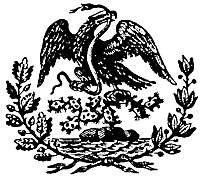
Arms of the United Mexican States (1823 to 1880) (official design)
Texas was originally part of New Spain, in the province of Nueva Felipinas (New Philippines), and later part of Mexico, first in the Internal Eastern State (Coahuila, Nuevo Leon, and Texas), and second in the State of Coahuila and Texas. The Spanish royal seal was replaced by the Mexican seal, which consists of an eagle holding a serpent and standing on a cactus, encircled by wreaths of oak and olive. The seal of Coahuila and Texas was similar to the Mexican seal:
- The seal shall contain, within the figure of an elipses, the eagle upon a nopal, crowned with the cap of liberty, with lines diverging therefrom, representing rays of light; the border of the oval bearing the following inscription: "Supreme Government of the Free State of Coahuila and Texas."
Governor Henry Smith's Private Seal
Governor Henry Smith, the head of the Provisional Government of Texas established in November 1835, used his private seal on December 28, 1835, to seal an official document appointing John Forbes, Sam Houston, and John Cameron as commissioners to negotiate with various Indian tribes: "I Henry Smith Governor as aforesaid have hereunto set my hand and affixed my private seal, no seal of office being yet provided." Some historians speculate that the private seal Smith used was actually a button which had an eight-petaled daisy design, but this cannot be confirmed by examining the original document in the custody of the Texas State Library and Archives Commission.
The 1836 "Peculiar Emblem"
On March 12, 1836, ten days after Texas declared independence from Mexico, the General Convention of the Texas Provisional Government adopted a resolution offered by George C. Childress, providing for "a single star of five points, either of gold or silver" as the "peculiar emblem" of the Republic. There is no known record that this emblem was ever used as an actual seal.
The 1836 National Seal
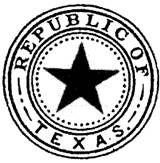
The 1836 Great Seal of the Republic of Texas
The 1836 Texas Constitution provided, "There shall be a seal of the republic, which shall be kept by the president, and used by him officially; it shall be called the great seal of the republic of Texas." A design for the national seal was not specified, however, so the constitution stated that the "president shall make use of his private seal until a seal of the republic shall be provided."
The First Congress remedied this situation in 1836 when it passed a bill providing that "for the future the national seal of this republic shall consist of a single star, with the letters 'Republic of Texas,' circular on said seal, which seal shall also be circular." President ad interim David G. Burnet proposed this design, and President Sam Houston, who replaced Burnet as president in October 1836, approved the design on December 10, 1836.
The 1839 National Arms and Seal
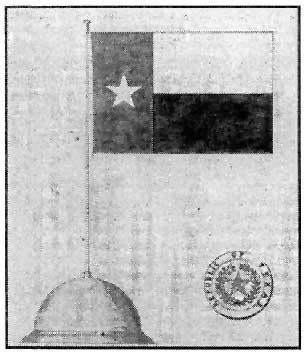
The 1839 National Flag of Texas and 1839 National Great Seal of the Republic of Texas (official design)
After initial hopes for the quick annexation of Texas into the United States grew dim, the Third Congress modified the seal and created a national arms in 1839:
- (T)he national arms of the Republic of Texas be, and the same is hereby declared to be a white star of five points, on an azure ground, encircled by an olive and live oak branches.
- ...(T)he national great seal of this Republic shall, from and after the passage of this act, bear the arms of this nation..., and the letters "Republic of Texas."
No one knows who first suggested the addition of the olive and live oak branches to the seal, but the Mexican national seal, which also contains wreaths of olive and oak, was the likely source. Senator William H. Wharton introduced a bill in the Texas Senate on December 28, 1838, to modify both the Texas seal and flag. The bill was referred to a committee chaired by Senator Oliver Jones, and President Mirabeau B. Lamar on January 25, 1839, approved a substitute bill offered by Jones. Jones' substitute bill contained the same design for the seal and flag originally proposed in Wharton's bill. Peter Krag executed an official rendition of the seal as well as the national flag. President Lamar approved Krag's art, which is attached to the act and currently in the custody of the Texas State Library and Archives Commission.
Senator Oliver Jones' Committee Report
The committee chaired by Senator Oliver Jones issued a report on January 4, 1839, concerning the national flag and seal, but it was never printed in the senate journal. The report is set out below exactly as it appears in the handwritten original that is in the custody of the Texas State Library and Archives Commission:
The Special Committee to whom the Act amending the Act entitled "An Act adopting a National Seal and Standard for the Republic of Texas" approved on the 10th December 1836 was referred, beg leave to
Report: That they have investigated the expediency of amending the act, contemplated by the Act submitted to them, and they have come to a conviction of the necessity of so amending the Law as to change the present form of the National Seal and Standard of the Republic, from motives which must appear self evident to every reflecting mind to be of the highest importance in a national point of view.
The Committee beg leave to make Some remarks of the ground upon which their Conviction is founded and are as follows-In the early part of the Year 1836 when the army and navy of the Republic of Texas were engaged in War against the Enemy, which resulted in the achievement of our Independence, the President ad interim devised the National flag and Seal, as it were in a case of emergency adopting the flag of the United States of America, with very little alteration, which act was subsequently ratified by the Law of 10th Dec 1836.
The then adopted flag was expedient for the time being, and has in many instances been beneficial to our Navy and Merchantmen, when encountered by the enemy forces, on account of being so much blended with the flag of the United States of America but the emergency has passed, and the future prospects of Texas are of such flattering nature that the National Independence requires that the Arms, Seal, and Standard assume also an Independent character, by a form, which will not blend them with those of any other nation.
Besides these considerations, the Committee would beg leave to state, that in as much as the proposition made by this Republic in her insipient stage of political existence to the United States of America, for an annexation to the American Confederacy has been withdrawn by the Minister of this Government at the Court of Washington, and as the wish of the majority of the people of Texas, so far as it is publicly known, is in favor of sustaining an Independent Station Among the Nations of the Earth, thereby the transition of the Single Star, into the American Constellation, and the emmerging the 13 Texian Stripes into the 26 Stripes of the United States of America inexpendient, the Committee are convinced of the necessity of adopting a Separate and Distinct Standard and Seal arms for this Republic, by so improving and embellishing the present as to fortify the Single Star with an olive and live oak branches, being emblems of Peace, and of the Materials of our strong arm of national defence in War, and indigenous to our Soil. Also the flag as proposed by the act, emblematical of Pease, & friendship, or War.
All Civilized Maritime Nations have adopted the National Standard for the use of their Naval and Commercial Services of such Colours and devises as to be plainly and distinctly perceived at great distances, and have carefully guarded against any thing that would blend them with the flags of any other and specially of a neighbouring nation, to avoid any Collision in time of war, by a neutral power; this ought to be the guide to Texas also, whose flag displaying the National Arms, the Committee flatter themselves, will be known and respected far and wide, so soon as this Commerce of this Country Nation is extended with the foreign Nations, protecting the valuable productions of her rich soil, on the widely extended Ocean and in the distant ports of the habitable globe.
Therefore your Committee beg leave to offer a Substitute, amending the original act referred to them, accompanying the Same with a Specimen of the Arms, the Seal and the Standard.
Oliver Jones
Chairman
Senator Jones mistakenly wrote that the proposed flag would display the national arms. That flag, as proposed and later adopted, featured only a single star rather than the proposed national arms, and it still flies today over Texas as the famous Lone Star Flag.
The 1845 State Seal
When Texas joined the Union in 1845 the new state constitution retained the seal, changing only the word "Republic" to "State." The 1845 constitution declared, "There shall be a seal of the State, which shall be kept by the Governor and used by him officially. The said seal shall be a star of five points, encircled by an olive and live oak branches, and the words 'the State of Texas.'" The 1861, 1866, and 1869 constitutions have similar language, and the current constitution of 1876 only adds that the seal shall be kept "by the secretary of state, and used by him officially under the supervision of the governor."
The 1956 Martinez Art
On November 19, 1946, the Pentagon's National Guard Bureau advised all states that the United States Air Force wanted state national guard aircraft to have identifying insignia on the fuselage. The Texas Adjutant General's Department decided to use the state seal as the identifying insignia. The department's chief engineer, Colonel Maybin H. Wilson, researched the design of the seal with the assistance of Werner W. Dornberger, an architectural engineering professor at The University of Texas; Bertha Brandt, assistant archivist of the state library; and Dorman Winfrey, archivist of The University of Texas. In 1956, Octavio A. Martinez, an architectural engineering student at The University of Texas, prepared an eighteen and three-fourth inch watercolor of the seal. This design was faithful to the constitutional description and omitted erroneous details that had crept into the seal over the years, such as the addition of stars and diamonds in the bottom of the seal's outer ring and the use of post oak leaves instead of live oak leaves. Unfortunately, the original Martinez watercolor has been lost.
The 1960 Schlattner Art
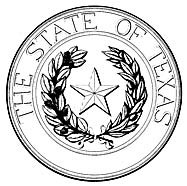
The Texas State Seal painted by Henry W. Schlattner
In 1960, the adjutant general, Major General K.L. Berry, and the executive director of the Texas Heritage Foundation, A. Garland Adair, commissioned Henry W. Schlattner, an architectural engineering student at The University of Texas, to paint six watercolors of the Martinez state seal. These watercolors were presented to Governor Price Daniel, the Battleship Texas, the Texas Memorial Museum, the Texas Senate, the Texas House of Representatives, and Travis B. Bryan, Sr., a descendant of Moses Austin. The Texas Legislature held a joint session on April 5, 1961, to receive the framed seals. Of these six watercolors, only the copy presented to the Texas Memorial Museum is known to exist.
The 1992 Official Design
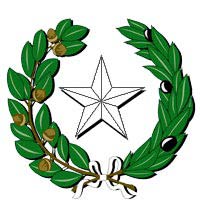
The Texas State Arms (official design)
By 1991, almost twenty different versions of the state seal were in use on state letterhead and publications. In response to the concerns of several state agencies about this lack of uniformity, Secretary of State John Hannah, Jr., appointed the Texas State Seal Advisory Committee to formulate recommendations on the design of the state seal. The members of this committee were Charles A. Spain, Jr., chair, Court of Appeals for the Third District of Texas; Donna D. Darling, cochair, Texas Water Development Board; Michael Green, Texas State Library and Archives Commission; Randy Jennings, Texas Rehabilitation Commission; Guy Joyner, Office of the Secretary of State; Shari Massingill, Texas Department of Health; Colonel John C. L. Scribner, Adjutant General's Department; Kimberly T. Sutton, Office of the Secretary of State; Ron Tyler, Texas State Historical Association; Juan Vega, Texas Water Development Board; and Douglas Young, State Preservation Board.
The committee researched the history of the state seal and recommended that the Texas Memorial Museum's 1960 watercolor by Henry W. Schlattner be used as a model. In addition, the committee developed standard black and white art of the state seal and state arms (the star and the live oak and olive branches) for use by all state offices, departments, and agencies. Juan Vega of the Texas Water Development Board designed the art. The secretary of state adopted the art in June 1992 as the official designs of the state seal and arms.

The Texas State Seal (official design)
Reverse of the State Seal
The 1961 Reverse
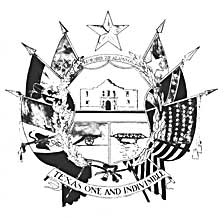
The 1961 Reverse of the Texas State Seal (official design)
The Daughters of the Republic of Texas proposed a design for the reverse of the state seal that was adopted by the Fifty-Seventh Legislature, Second Called Session. Governor Price Daniel approved this concurrent resolution on August 26, 1961. Sarah R. Farnsworth designed the art for the seal's reverse. This design was unusual because the legislature adopted the art itself as the reverse of the state seal, as opposed to the usual practice of adopting a description, or blazon, which is later rendered by an artist. The legislature's concurrent resolution adopting the seal's reverse also contained a description of the art. Unfortunately, the description in the concurrent resolution disagreed in some respects with the art, and the art itself suffered from minor inaccuracies.
The 1991 Modification to the Reverse
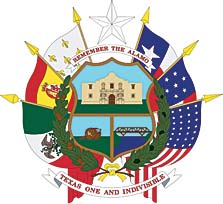
The Reverse of the Texas State Seal (official design)
The Seventy-Second Legislature modified the description of the reverse of the state seal as follows:
- RESOLVED, That the design for the reverse side of the Great Seal of Texas shall consist of a shield, the lower half of which is divided into two parts; on the shield's lower left is a depiction of the cannon of the Battle at Gonzales; on the shield's lower right is a depiction of Vince's Bridge; on the upper half of the shield is a depiction of the Alamo; the shield is circled by live oak and olive branches, and the unfurled flags of the Kingdom of France, the Kingdom of Spain, the United Mexican States, the Republic of Texas, the Confederate States of America, and the United States of America; above the shield is emblazoned the motto, "REMEMBER THE ALAMO", and beneath the shield are the words, "TEXAS ONE AND INDIVISIBLE"; over the entire shield, centered between the flags, is a white five-pointed star...
Governor Ann W. Richards approved this concurrent resolution on June 14, 1991.
This modification was made to correct minor inaccuracies in the 1961 description and to adopt a description of the design, rather than specific art. The legislature's action was taken to allow the State Preservation Board to obtain revised art for the seal's reverse that was suitable for use in the underground extension of the state capitol. Alfred Znamierowski painted the art under the supervision of Whitney Smith, executive director of the Flag Research Center, and it was revised and completed by Douglas Young of the State Preservation Board. On the recommendation of the Texas State Seal Advisory Committee, Secretary of State John Hannah, Jr., adopted this art as the official design for the reverse of the state seal in June 1992 for use by all state offices, departments, and agencies.
The Seventy-Third Legislature enacted the description of the reverse of the state seal, as well as the description of the state arms, as article 6139f of the Revised Statutes. The reverse of the state seal now appears in color on the floor of an underground rotunda in the capitol extension.
Is It a Great Seal or Not?
Before 1993, the state seal was referred to in some laws as the "Great Seal of Texas." There was disagreement about whether this was correct because the constitution uses the terms "seal of the State" and "State seal," and because the Texas Supreme Court in 1846 defined the term "great seal" to mean the seal of a nation, as opposed to a state seal.
In 1993, the Seventy-Third Legislature amended those laws that used the term "Great Seal of Texas" and substituted the term "state seal." It seems likely, however, that Texans will continue to regard their seal as a great seal regardless of its name.
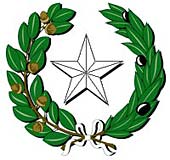
Uses of the State Seal, Arms, and Reverse
The state seal is required by law to be affixed to numerous documents, such as commissions for elected and appointed state and local officials; patents for land from the state; executive acts of the governor in criminal cases such as remissions of fines, reprieves, commutations of punishment, extraditions, and pardons; state bonds; and all official documents issued from the office of the secretary of state. By law the state seal also appears on gold and silver state coins; the Texas Distinguished Service Medal, which is awarded to citizens who have achieved conspicuous success while rendering outstanding service to the state; and all state aircraft except those used for law-enforcement purposes.
The secretary of state's office currently has six mechanical presses and dies used to affix the state seal as required by law. Two additional presses and dies also exist that are no longer functional. The age and design of all these presses and dies varies, but each is recognized as the state seal for legal purposes. The state arms and reverse of the state seal are used exclusively as symbols of the state and do not have any independent legal significance.
Private use of the state seal, including the state arms and reverse of the state seal, is regulated by law. The state seal may be used for commercial purposes only if a license is obtained from the secretary of state and royalties are paid to the state. Persons seeking more information on private use of the state seal should contact the office of the secretary of state. Additionally, it is a criminal offense for a person other than a political officeholder knowingly to use a representation of the state seal in political advertising.
